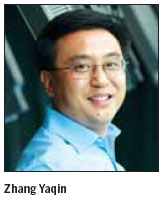Business
Tech drives new economy
By Zhang Yaqin (China Daily)
Updated: 2012-09-11

Global business, academic and political leaders are gathering in Tianjin this week for the sixth annual World Economic Forum's Annual Meeting of the New Champions, also known as the Summer Davos.
Experts and insiders agree that the world is experiencing a leap in the evolution of technology and innovation. This is transforming industry and society while giving rise to the foundations of a future economy.
Accelerated technological progress promises to change the world and provide solutions to some of our most pressing societal challenges.
At the nexus of this evolution is China, and it is here that Microsoft has placed its hopes as it fully embraces a new era.
Microsoft and its leadership team have created a new strategy for China that will help support the nation in this new chapter of its development.
This partnership aims to drive and promote the next era of innovation, competitiveness and opportunities that are emerging on an unfathomable scale.
Such a strategy is actuated, on our part, by a long presence and deep investment in China, particularly in the Zhongguancun Science Park, China's Silicon Valley, where Microsoft has been headquartered for more than 20 years.
In Zhongguancun - home to China's top multinational R&D centers - we transform our vision into action, just as across the country, manufacturing is being transformed into innovation. We do so by creating state-of-the-art technology, investing in our ecosystem and encouraging and protecting an environment that supports creativity, entrepreneurship and local innovation.
But even in a hotspot like Zhongguancun, innovation does not always come easily. And if we want to foster it - from the spark of an idea to the launch of a new product - we have to support a culture of entrepreneurship that acknowledges advancement is impossible without the risk of failure.
Microsoft is helping to shape this culture by providing a supportive community for entrepreneurs and startups through Accelerator for Windows Azure.
As we step into the next era, the world is waking up to cloud computing.
Accelerator provides resources to startups, encouraging them to be pioneers in the adoption of the cloud platform and to help expand its role in entrepreneurship and innovation.
We are thrilled to welcome 10 exciting young firms into our Accelerator program. They join us in our Asia Research and Development campus in Zhongguancun, Haidian district, where they are surrounded by more than 2,000 Microsoft engineers and scientists and nurtured in this center of innovation. They form part of a supportive community and culture of entrepreneurship that provides a safety net while accepting that failure is all a part of the journey toward success.
Aside from having the opportunity to turn their business dreams into reality, these young people are also helping cloud computing fulfill its potential as a catalyst for China's advancement. As an initiative, Accelerator helps put China in a unique position to lead the upcoming wave of cloud development.
According to recent research conducted by the International Development Council, by the end of 2015, nearly 14 million new jobs worldwide will be created as a result of cloud computing. China is on track to take up a large share of these jobs, and those who have glimpsed China's potential should not be surprised.
Zhongguancun is central to innovation not only for its R&D centers but also for its proximity to China's top universities for technology. These universities are teeming with talented people who will be encouraged and motivated by seeing the opportunities available to those - like our Accelerator startups - who have a combination of courage, creativity and ambition.
Through our relationships with these startups, the Chinese government and the people of this nation, we are going to see investments and incubations blossom into new technologies and companies that will not only transform Zhongguancun into a global center of innovation but will also benefit society and the economy on a global scale, paving the way for the next generation of New Champions.
The author is corporate vice-president of Microsoft and chairman of the Microsoft Asia-Pacific R&D Group
(China Daily 09/11/2012 page6)
